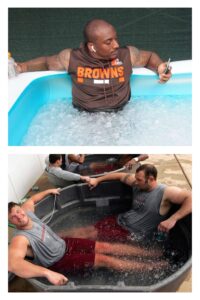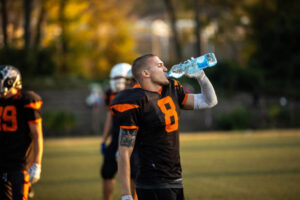After a grueling workout or an intense sports game, particularly for athletes like college football players and NFL professionals, recovery is just as crucial as the effort put into training. Post-workout recovery isn’t only about rest—it’s a multifaceted process that includes physical, nutritional, and mental components. Understanding what to do after heavy physical exertion can enhance performance, promote muscle growth, prevent injury, and contribute to overall well-being.
1. Immediate Cool-Down Cryotherapy, Ice Baths, and Compression
and Stretching
After the final whistle blows, the recovery process begins immediately. One of the first steps is engaging in a proper cool-down session. This helps gradually lower the heart rate, improves circulation, and aids in the removal of metabolic waste like lactic acid from the muscles. Light jogging or walking followed by dynamic and static stretching helps reduce muscle tightness and decreases soreness.
Cold therapies are widely used to reduce inflammation and muscle soreness. NFL players often submerge in ice baths for 10–15 minutes after games, while others opt for cryotherapy chambers. Compression gear or pneumatic compression devices also aid in reducing swelling and promoting circulation.
For college football players and NFL athletes, the intense nature of the gam e—explosive sprints, full-contact plays, and abrupt directional changes—leaves muscles fatigued and prone to tightness. Incorporating foam rolling or massage therapy can also be beneficial, breaking up adhesions in muscle tissue and promoting recovery. So an ice bath immediately after a game is essential and beneficial.
e—explosive sprints, full-contact plays, and abrupt directional changes—leaves muscles fatigued and prone to tightness. Incorporating foam rolling or massage therapy can also be beneficial, breaking up adhesions in muscle tissue and promoting recovery. So an ice bath immediately after a game is essential and beneficial.
2. Nutrition for Recovery and Muscle Building
One of the most important elements of post-workout recovery is nutrition. What you eat after a heavy workout or game directly affects your body’s ability to repair and rebuild muscles. For high-performance athletes like football players, refueling properly ensures they’re ready for the next practice or game.
Protein and Muscle Repair:
Consuming high-quality protein within 30–60 minutes after exercise helps initiate muscle repair. Proteins rich in essential amino acids, especially leucine, stimulate muscle protein synthesis. Good options include:
- Grilled chicken or turkey breast
- Whey or casein protein shakes
- Eggs or egg whites
- Greek yogurt
NFL players often rely on customized protein shakes formulated by team nutritionists to meet their specific caloric and macronutrient needs.
Carbohydrates to Replenish Glycogen:
High-intensity workouts and games deplete glycogen stores in muscles. Replenishing these stores with carbohydrates is essential to maintain energy and avoid fatigue in future sessions. Ideal carbohydrate sources include:
- Brown rice, quinoa, or sweet potatoes
- Whole grain pasta or bread
- Fruits like bananas, berries, or apples
The carbohydrate-to-protein ratio post-workout is typically 3:1 or 4:1, depending on the intensity and duration of the activity. NFL and college teams often provide players with post-game meals or recovery shakes with a balance of macronutrients to optimize recovery.
Micronutrients and Antioxidants:
Vitamins and minerals like magnesium, potassium, and calcium play a role in muscle contraction and recovery. Foods like spinach, avocado, nuts, and berries help reduce inflammation and oxidative stress caused by intense exercise.
3. Hydration: More Than Just Water
Staying hydrated is essential for all athletes, but particularly for football players who often train and play in high-temperature environments wearing heavy gear. Dehydration can impair performance, slow recovery, and increase the risk of cramps and injury.
Water:
Plain water should be the foundation of any rehydration plan. Athletes should begin hydrating during the game or workout and continue afterward. A good rule of thumb is to drink 16–24 ounces of water for every pound of body weight lost through sweat.
Electrolyte Drinks:
Electrolyte-rich fluids like sports drinks can help replace sodium, potassium, and magnesium lost in sweat. These are especially useful during long practices, two-a-days, or games played in hot climates.
Coconut Water and Milk:
Natural sources like coconut water offer potassium and magnesium with fewer artificial additives. Low-fat chocolate milk is also a favorite among athletes for its ideal carb-to-protein ratio and hydrating properties.
Hydration Monitors:
In both college and NFL settings, athletic trainers often use urine color charts or hydration testing devices to ensure players maintain proper hydration levels, especially during pre-season training camps.
4. Sleep and Rest
Sleep is often underestimated in athletic recovery, but it plays a vital role in muscle repair, hormonal balance, and cognitive function. NFL and college coaches increasingly emphasize sleep as part of a comprehensive recovery protocol.
Football players should aim for at least 7–9 hours of quality sleep. Creating a bedtime routine, avoiding screens before bed, and sleeping in a cool, dark environment can improve sleep quality. Some teams even schedule nap times or provide sleep pods at training facilities to encourage adequate rest.
Creating a bedtime routine, avoiding screens before bed, and sleeping in a cool, dark environment can improve sleep quality. Some teams even schedule nap times or provide sleep pods at training facilities to encourage adequate rest.
5. Mental Recovery and Relaxation
Mental fatigue can be just as taxing as physical fatigue. The pressure to perform, manage injuries, or compete for a spot on the roster adds significant psychological stress. Recovery isn’t complete without addressing the mental side of performance.
Mindfulness and Meditation:
Practices like deep breathing, meditation, or progressive muscle relaxation help reduce cortisol levels and promote relaxation. NFL teams such as the Seattle Seahawks have incorporated mindfulness into their routine to boost focus and reduce anxiety.
Visualization and Mental Rehearsal:
College and pro players alike benefit from visualization techniques. Mentally replaying plays or imagining successful outcomes helps reinforce neural patterns and reduce performance-related anxiety.
Talking to a Professional:
Sports psychologists are becoming more common in collegiate and professional sports settings. They assist players in developing mental resilience, managing stress, and setting performance goals.
6. Active Recovery and Light Movement
On the day following a heavy workout or game, engaging in light physical activity—like swimming, cycling, or yoga—helps stimulate blood flow, deliver nutrients to tired muscles, and enhance recovery. NFL teams often schedule “recovery days” post-game that include these low-intensity activities.
Conclusion
Post-workout recovery is a comprehensive process that includes cooling down, consuming the right nutrients, staying hydrated, sleeping well, and addressing mental fatigue. For elite athletes like college football players and NFL pros, prioritizing recovery is not optional—it’s essential. By implementing a well-rounded recovery routine, athletes can enhance performance, extend careers, and maintain both physical and mental health in the face of demanding schedules and high-intensity competition.
JOIN IN ON THE DISCUSSION HERE
- National Institute on Drug Abuse (NIDA) – Anabolic Steroids
https://nida.nih.gov/research-topics/anabolic-steroids - Wikipedia – Anabolic Steroid
https://en.wikipedia.org/wiki/Anabolic_steroid - Wikipedia – Performance-Enhancing Substance
https://en.wikipedia.org/wiki/Performance-enhancing_substance - StatPearls (NCBI) – Anabolic Steroids
https://www.ncbi.nlm.nih.gov/books/NBK482418/ - ScienceDirect – Steroid Abuse in the Fitness Community
https://www.sciencedirect.com/science/article/pii/S2667118225000030 - University Hospitals – How Steroids Harm an Athlete’s Body and Mind
https://www.uhhospitals.org/blog/articles/2025/06/how-steroids-harm-an-athletes-body-and-mind - Wikipedia – Sports Nutrition
https://en.wikipedia.org/wiki/Sports_nutrition - Wikipedia – Doping in Sport
https://en.wikipedia.org/wiki/Doping_in_sport



 * [Santelog – First Steroid Cycle 2025: Experts Discuss Science Behind Beginner’s Guide](https://www.santelog.com/actualites-sante-nasdaq/first-steroid-cycle-2025-experts-discuss-science-behind-beginners-guide?utm_source=chatgpt.com) * [Swolverine – Testosterone for Beginners: Foundation of All Steroids](https://swolverine.com/blogs/blog/testosterone-for-beginners-what-you-need-to-know-about-the-foundation-of-all-steroids?srsltid=AfmBOoqCC-dSYCCLzS_aBUE9R2UrzUwlIeQTThc1SHtn0PrDe-sUv5tK&utm_source=chatgpt.com) * [Swolverine – Ultimate Guide to Post Cycle Therapy](https://swolverine.com/blogs/blog/ultimate-guide-to-post-cycle-therapy-reclaim-your-gains-and-restore-hormonal-balance?srsltid=AfmBOoqIedo-hSzwJWKVyOakO8QOG8Ex4eQPq8T0ZgfbDGumXh4v0gKN&utm_source=chatgpt.com) * [Swolverine – Cycle Length by Compound: Steroids, SARMs, Peptides](https://swolverine.com/blogs/blog/cycle-length-by-compound-steroids-sarms-peptides-full-guide-for-bodybuilders?srsltid=AfmBOop_lD04o8YU_g2b_B6B7MysdBhMn-DjUTpJ2i8gsPVyntVWRFW2&utm_source=chatgpt.com) * [Harley Street MD – Post Cycle Therapy Guide](https://harleystreet-md.co.uk/blog/post-cycle-therapy/?utm_source=chatgpt.com) * [Ro Health – Clomid for Post Cycle Therapy](https://ro.co/erectile-dysfunction/clomid-for-post-cycle-therapy/?utm_source=chatgpt.com) * [Endocrine Society – Press Release: Post-Cycle Therapy Research](https://www.endocrine.org/news-and-advocacy/news-room/2023/endo-2023-press-jayasena?utm_source=chatgpt.com) * [NCBI Bookshelf – Testosterone Cypionate Clinical Use](https://www.ncbi.nlm.nih.gov/books/NBK482418/?utm_source=chatgpt.com) * [PMC – Patterns and Side Effects of Anabolic Steroid Use](https://pmc.ncbi.nlm.nih.gov/articles/PMC10640727/?utm_source=chatgpt.com) --- anabolic steroids, first cycle, beginners guide, testosterone enanthate, testosterone cypionate, bodybuilding tips, steroid cycle plan, post cycle therapy, PCT guide, Clomid, Nolvadex, testosterone suppression, sexual recovery, steroid side effects, safe steroid use, hormone recovery, training optimization, steroid psychology, cycle length, beginner cycle, health monitoring, injection cycle, estrogen control, hormonal suppression, testosterone dosage, recovery protocol, steroid education, controlled cycle, responsible cycle, muscle health](https://steroidology.com/wp-content/uploads/2025/09/istockphoto-597631958-612x612-1.jpg)


